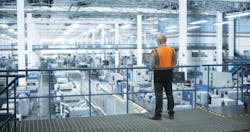Autonomous operations will depend on a long list of advanced technologies
Key highlights
- Artificial intelligence, robotics, machine vision and digital twins are converging to enable smarter, more autonomous manufacturing systems.
- Mobile and collaborative robots are critical components in extending automation capabilities across flexible and complex industrial environments.
- Many technologies are foundational for enabling machines to make real-time decisions, self-correct errors and optimize workflows without human intervention.
In a factory with no humans, advanced technologies take their place. Even a fully autonomous, lights-out operation may still need human oversight in some form, in case of equipment failure or security risk. Maybe our future factories will run completely by artificial intelligence (AI)-enabled robots and systems. However, with industry’s current technology, experts foresee autonomous machines and systems but within some constraints.
The adoption of robotics on the factory floor is ever increasing, but the technology has some current limitations. As with many technologies, invention may overcome those challenges eventually, but an interdependence among the many technologies will need to coalesce as they advance for autonomy to become a reality. Some of the advanced technologies include robotics, artificial intelligence, machine vision, digital twins, edge computing and advanced motion control.
Industrial robotics will connect machines and systems, moving and handling material
Modern industrial robots can perform complex tasks with high precision, and higher precision has opened the door to more applications. “By processing and analyzing visual data in real time, machine vision systems enable robots to identify defects, guide precise assembly operations and navigate complex environments autonomously. Autonomous mobile robots (AMRs) utilize advanced sensors and navigation algorithms to transport materials within manufacturing facilities, optimizing internal logistics and conveyance,” says Tim Guelde, application engineering manager at Wauseon Machine.
The increased adoption of mobile and collaborative robotics over the past five years has allowed Comau to reach new industries, such as aerospace and renewable energy. “Automation has evolved over the past five-plus years from largely fixed production lines to flexible, AI and vision-enhanced systems capable of handling complex, unstructured tasks,” says Alessandro Piscioneri, head of products and solutions management of Comau. “These advancements highlight a broader trend of automation moving beyond large-scale industrial settings into applications that require adaptability, intelligence and precision.”
Autonomous mobile robots, like their more fixed and routed robot siblings, automated guided vehicles (AGVs); they can use AI to learn routes and avoid obstacles; and they’ve proven reliable for moving work-in-progress production from workstation to workstation. “In many material-handling operations, fully autonomous operations are possible within a given size envelope for the containers/pallets. AMRs can extend the capabilities of these installations, reducing or eliminating the need for fork trucks and other manual handling applications,” says Pal Roach, senior principal industry consultant for oil and gas at Rockwell Automation.
AMRs have shown significant impact across various industries, such as flexible factories, logistics and warehousing says Eric Kraus, director of sales and automation, Doig. “AMRs are particularly effective in flexible factories where floorplans may change frequently. They are used for tasks such as material handling, inventory tracking and mobile manipulation. They are also applied in light assembly, packaging, logistics and warehousing,” he adds.
Artificial intelligence will lead autonomy, with help from other technologies
Dr. André Scholz, head of innovation department: autonomous factory, at Siemens, says the main driver for the adoption of autonomous operations is artificial intelligence. “The usage of camera data is another key enabler to gather information about the current situation. With deep learning, reinforcement learning and vision-language models, new ways to use robots are being discovered,” Scholz says.
Andrew Borczak, industry marketing manager, Omron, says a number of other technologies make autonomous robotics possible, including edge computing, machine vision, digital twins and advanced motion control, as well as artificial intelligence. “Today, autonomous operations aren’t just about machines replacing humans. It’s about systems making decisions. They adjust parameters in real time, self-correct errors and even orchestrate workflows without human intervention to improve efficiency, reduce risk and generate return on investment (ROI). The focus has shifted from ‘Can we automate?’ to ‘How do we make automation smarter?’” he adds.
Get your subscription to Control Design’s daily newsletter.
Artificial intelligence can make automation smarter in combination with these many other technologies, and manufacturers will move from automating repetitive tasks and quality inspections with basic vision systems to autonomous material handling, predictive maintenance and real-time process optimization.
“In the past five years, manufacturing customers have increasingly focused on automating processes using advanced technologies like Industrial Internet of Things (IIoT), digital twins and machine vision. These innovations enable real-time data collection, predictive maintenance and improved decision-making. The adoption of cobots has also grown, allowing for safer and more efficient human-robot collaboration,” says Cliff Ortmeyer, head of solutions at Newark.
“Cobots are revolutionizing assembly lines by enhancing precision and adaptability. The integration of machine vision with deep learning is transforming quality-control processes, allowing for real-time defect detection,” says Anjesh Shekhar, product marketing manager of networking at Balluff. “In logistics and material handling, AMRs and AI-based systems enhance efficiency by dynamically optimizing routes and workflows.”
Many industries have automated parts of a production process with robots operating workcells or packaging the final product for distribution or AMRs transporting material between workcells and to packaging. However, end-to-end autonomous operations are rare, and most still require some human oversight. The right technologies are in place to advance autonomy as operations begin to connect all the machines and robots into an intelligent system.
Next steps
- Evaluate current systems for integration opportunities with AI-driven tools like machine vision, edge computing or digital twins to enhance autonomous decision-making.
- Investigate how mobile robots and cobots could be applied in existing or new production lines to reduce manual handling and increase operational flexibility.
About the Author
Anna Townshend
Managing Editor
Anna Townshend has been a writer and journalist for 20 years. Previously, she was the editor of Marina Dock Age and International Dredging Review, until she joined Endeavor Business Media in June 2020. She is the managing editor of Control Design and Plant Services.

Leaders relevant to this article:

